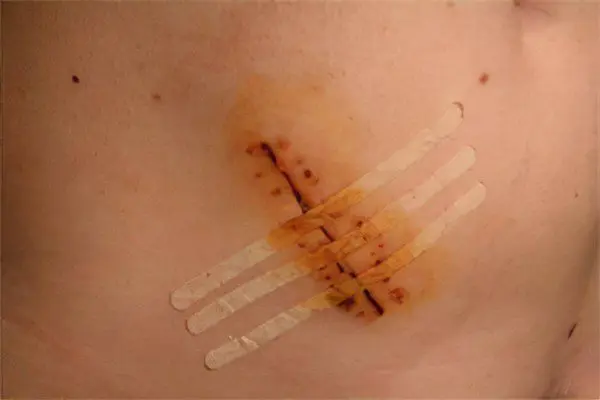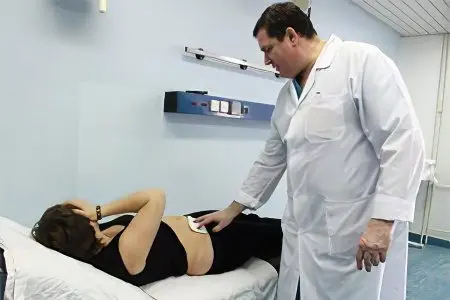Contents

The result of the operation, not associated with the treatment of a purulent wound, is the closure of the surgical field by suturing. If the tissues are infected, the surgeon creates an opportunity to remove pus and reduce the volume of infiltration. The suture material used in surgery may be of natural origin or be synthetic. Ligature sutures may dissolve spontaneously some time after surgery, or they will require the help of a doctor to remove them.
If a serous liquid of a dark cherry color, or purulent discharge, is released at the suture site, this is a sign of a developed inflammatory process and the formation of a ligature fistula. The appearance of these symptoms is a sign of ligature rejection and a reason for resuming treatment. The fistula that appeared after the operation cannot be considered as a normal phenomenon, urgent treatment is required under the guidance of a surgeon.
Reasons for the appearance of a ligature fistula:
Infection in the wound due to ignoring the requirements of antiseptics;
Allergic reaction to suture material.
Features of ligature fistulas:
Occur in any part of the body;
Occur in all types of tissue of the human body (epidermis, muscle tissue, fascia);
Arise after any time (week, month, year) after the operation;
They have a different deployment of the clinical picture (sutures can be rejected by the body with further wound healing, or they can become intensely inflamed with suppuration of the wound and not heal);
Occur regardless of the material of the ligature threads.
Risk Factors
There are factors that increase the likelihood of a postoperative fistula:
Patient’s age;
Immune reactivity (in young people it is usually higher);
Accession of a chronic infection;
Hospital infection, typical for surgical and therapeutic hospitals;
Getting into the wound of staphylococcus and streptococcus, which is normally always on the skin of a person;
Localization and type of surgical intervention (caesarean section, surgery for paraproctitis, etc.);
Protein depletion in oncological diseases;
Deficiency of vitamins and minerals;
Metabolic disorders (diabetes mellitus, obesity, metabolic disorders).
Symptoms of a ligature fistula

The development of postoperative fistula occurs according to the following scenario:
Within a few days after the operation, the wound area thickens, swells slightly, and becomes painful. The skin around it turns red, becomes hotter to the touch than other areas.
After 6-7 days, when pressed, serous fluid and pus come out from under the seam.
The general body temperature rises to subfebrile values (37,5-38°).
The fistulous tract may spontaneously close, then reopen later.
Recovery is possible only after a second operation.
Complications arising from the appearance of a postoperative fistula
Abscess – a cavity filled with pus;
Phlegmon – inclusion in the inflammatory process of subcutaneous fat;
Eventration – prolapse of internal organs due to purulent fusion of tissues;
Sepsis – the spread of purulent contents in the cavity of the chest, skull, in the abdominal cavity;
Toxic-resorptive fever – severe hyperthermia, as a reaction of the body.
Diagnostics

The primary diagnosis of the ligature fistula is carried out in the dressing room during a visual examination of the wound by the surgeon. To clarify the localization of the fistula, the presence or absence of complications (abscess, purulent streaks), ultrasound of the surgical wound is performed.
If the fistula is located in the thickness of the tissues, and its diagnosis is difficult, fistulography is used. During the examination, a contrast agent is injected into the fistulous tract and radiography is performed. As a result of such manipulation, the fistulous tract will be clearly visible on the x-ray.
Treatment of ligature fistula
The vast majority of cases of ligature fistula can only be resolved by surgery. The longer there is a postoperative fistula, the more difficult it is to cure. For treatment, complex therapy with the use of medicines is used.
Groups of drugs used to treat fistula:
Antiseptics of local action;
Antibacterial agents;
Enzymes for the destruction of dead tissue.
In addition to surgical and medical treatment, physiotherapy is used:
Quartzation of the wound surface. Quartzization has a detrimental effect on pathogenic bacteria, contributing to a stable remission of the process, although it does not guarantee a complete recovery.
UHF therapy. microcirculation of blood and lymph improves, which leads to a decrease in edema and an end to the spread of infection.
The “gold standard” for the treatment of ligature fistula is an operation that allows you to eliminate the problem completely. After the operation, the patient needs dressings, washing the drainage. If the purulent discharge is not fixed, the drainage is removed.
Local revision of inflamed tissues with a wide dissection of the fistula is a classic form of surgical treatment of postoperative fistula. Most minimally invasive techniques are ineffective in the treatment of this complication.
Prognosis and prevention
In cases of rejection by the body of surgical threads from any material, the prognosis of the operation is unfavorable. The situation is the same with self-treatment – the forecast in this case is very difficult to make.
It is impossible to apply preventive measures for the appearance of a fistula, since even with strict observance of antiseptics, infection can enter the surgical wound and rejection of the suture material.









